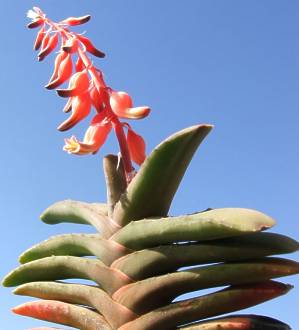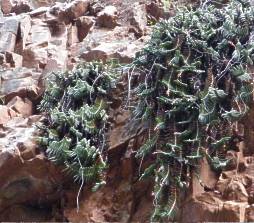Gasteria rawlinsonii
Gasteria rawlinsonii Oberm.
Family: Asphodelaceae
Common names: Baviaanskloof cliff gasteria (Eng.); kransbeestong (Afr.)
Introduction
Gasteria rawlinsonii is a shrubby, aloe-like, succulent cliff hanger found only in the Baviaanskloof of the Eastern Cape Province. It is the only species of Gasteria with pendulous (hanging downwards) stems.

Description
Description
This Gasteria is a long-lived, drooping succulent shrub with long leafy stems. Its roots are succulent and up to 3 mm in diameter. Plants are branched from the base with stems becoming pendulous and up to 1000 mm long. The succulent leaves are ascending-spreading and arranged in two rows (distichous) or in a spiral at a distance of 10-20 mm from each other. The leaves are narrow (linear), strap-shaped (lorate), slightly sickle-shaped (falcate), recurved at the ends and 30-80 x 10-25 mm. They are green, brownish green to reddish green, and rarely with faint white spots. When fully swollen (turgid) they are very fleshy and often rounded (biconvex). The leaf surface (epidermis) is rough (asperulous) and the margins have sparse prickles or are sometimes unarmed. The prickles turn black with age, and the leaf ends (apex/apices) are blunt (obtuse) with a small sharp point (mucronate).

The inflorescence is a simple elongate raceme up to about 100-500 mm long. The reddish pink flowers are tubular and swollen in the basal portion (gasteriform), 16-25 mm long, with the upper part of the tube 4-6 mm in diameter and the swollen basal part 6-9 mm in diameter. The stamens are 17 mm long. The ovary is egg-shaped (oblong-ovoid), 5 x 2-3 mm, and its style is 11-12 mm long. The fruiting capsule is 18 mm long and the black seeds are 3-4 mm wide.
Conservation Status
Status
Gasteria rawlinsonii, although restricted to an inaccessible cliff face habit, is locally common and well protected by nature. The plant is also well established in cultivation (ex situ conservation) and grown by succulent plant growers all over the world.

Distribution and habitat
Distribution description
Gasteria rawlinsonii is restricted to the Baviaanskloof and Kouga Mountains of the Eastern Cape Province where it grows on sheer cliff faces in narrow, often shady north-south running kloofs on mineral-poor quartzitic sandstone soils at an altitude of 300-700 m. Although they grow on all aspects, plants are more common on shady south-facing sites. Rainfall occurs mainly during winter and summer and averages about 200-300 mm per annum. Temperature is hot during summer and mild to warm in winter, and frost is absent. The average daily maximum is about 25°C and the average daily minimum about 9°C. The associated vegetation consists of Gamtoos Thicket of the Albany Thicket Biome (Mucina & Rutherford 2006). Gasteria rawlinsonii shares its habitat with other cliff-dwelling plants such as Bulbine cremnophila, Cyrtanthus montanus, C. labiatus, Haworthia gracilis var. picturata, H. viscosa, Plectranthus verticillatus, Othonna lobata, Cotyledon tomentosa subsp. tomentosa, Adromischus cristatus var. zeyheri, Delosperma esterhuyseniae and Albuca cremnophila. The rock formations consist of quartzitic sandstone of the Peninsula Formation (Cape Supergroup).
Derivation of name and historical aspects
History
The specific name (Gasteria rawlinsonii) honours Mr I. Rawlinson from Bloemfontein (Free State), a South African collector and grower of succulent plants. It was named by Amelia Obermeyer (1976) in the series Flowering Plants of Africa. Gasteria rawlinsonii is one of 23 Gasteria species (Van Jaarsveld 2007) of which most are endemic to South Africa, occurring mainly below the inland escarpment of the Eastern Cape. The genus Gasteria is closely related to Aloe but differs in having pendulous flowers with a belly-like basal swelling from which the Greek generic name Gasteria was derived (gaster = stomach). Another distinguishing feature are the mostly brittle leaves which can proliferate vegetatively by producing new plantlets (Van Jaarsveld 1994).
Ecology
Ecology
Gasteria rawlinsonii grows on sheer cliff faces and on rock ledges. Plants are long-lived with long leafy stems (covered with perennial and functional leaves withering from the base). The leaves when fully swollen (turgid) are very fleshy, thus storing enough water for survival in the dry cliff face habitat. The leaf margins are almost smooth in the distichous type (only slightly crenate-tuberculate at its apices) suggesting a reduction in armament in response to its undisturbed cliff habitat, in contrast to the often thorny but grazed surrounding thicket vegetation. Gasteria rawlinsonii is pollinated by sunbirds.
The capsules are oriented in an erect position which is typical of Gasteria species. The seeds ripen during late spring with the onset of the rainy season. They are dispersed by the wind. Unlike other Gasteria species its leaves are not brittle, neither do they proliferate when detached (in rare cases plants might proliferate), suggesting a loss of this ability due to its cliff habitat.
Uses
Use
The species is used in horticulture but not medicinally.
Growing Gasteria rawlinsonii
Grow
Gasteria rawlinsonii is a worthwhile introduction to horticulture.It is not difficult to grow or propagate but it is a very slow grower. Out-of-doors it is best cultivated in Thicket Gardens. It thrives on rockeries or steep embankments. Outside its native habitat it is best grown in a greenhouse under controlled conditions. Plants prefer partial shade, and in hot climates should therefore be protected from full sun. As they grow very slowly they will only reach flowering size after about four years.
Propagation
Easily propagated from seed or cuttings, however a fungicide should be applied especially when grown from seed. Sow seed during spring or summer in a warm, shady position in a sandy slightly acidic soil and keep moist. Cover with a thin layer of sand and keep moist. Germination usually occurs within three weeks. Seedlings grow very slowly and are best planted out about two years after sowing. Propagation from cuttings is best done in spring. Stems of about 40-80 mm length are ideal. Cuttings are best rooted in clean sand. Once rooted, plants can be planted into individual containers. They are excellent for growing in containers, and older plants will become pendulous. Best grown in a sandy, slightly acidic soil mixture. Plants react well to organic feeding (compost or any other liquid fertilizer). Plants are grown at Kirstenbosch National Botanical Garden and on display in the Botanical Society Conservatory. Gasteria rawlinsonii can be watered at any time of the year. Watering during winter should be reduced, but during long dry hot spells a good watering is recommended.
References
- MUCINA, L. & RUTHERFORD, M.C. (eds) 2006. The vegetation of South Africa, Lesotho and Swaziland. Strelitzia 19. South African National Biodiversity Institute, Pretoria.
- OBERMEYER, A. 1976. Gasteria rawlinsonii Oberm. Flowering Plants of Africa 43: 1701.
- VAN JAARSVELD, E.J. 1994. Gasterias of South Africa. Fernwood Press.
- VAN JAARSVELD, E.J. 2007. The genus Gasteria : a synoptic review (new taxa and combinations). Aloe 44:4:2007: 84-102.
Credits
Ernst van Jaarsveld
Kirstenbosch National Botanical Garden
November 2009
Plant Attributes:
Plant Type: Succulent
SA Distribution: Eastern Cape
Soil type: Sandy
Flowering season: Spring
PH: Acid
Flower colour: Pink
Aspect: Shade
Gardening skill: Average
Special Features:
Horticultural zones








Rate this article
Article well written and informative
Rate this plant
Is this an interesting plant?
Login to add your Comment
Back to topNot registered yet? Click here to register.